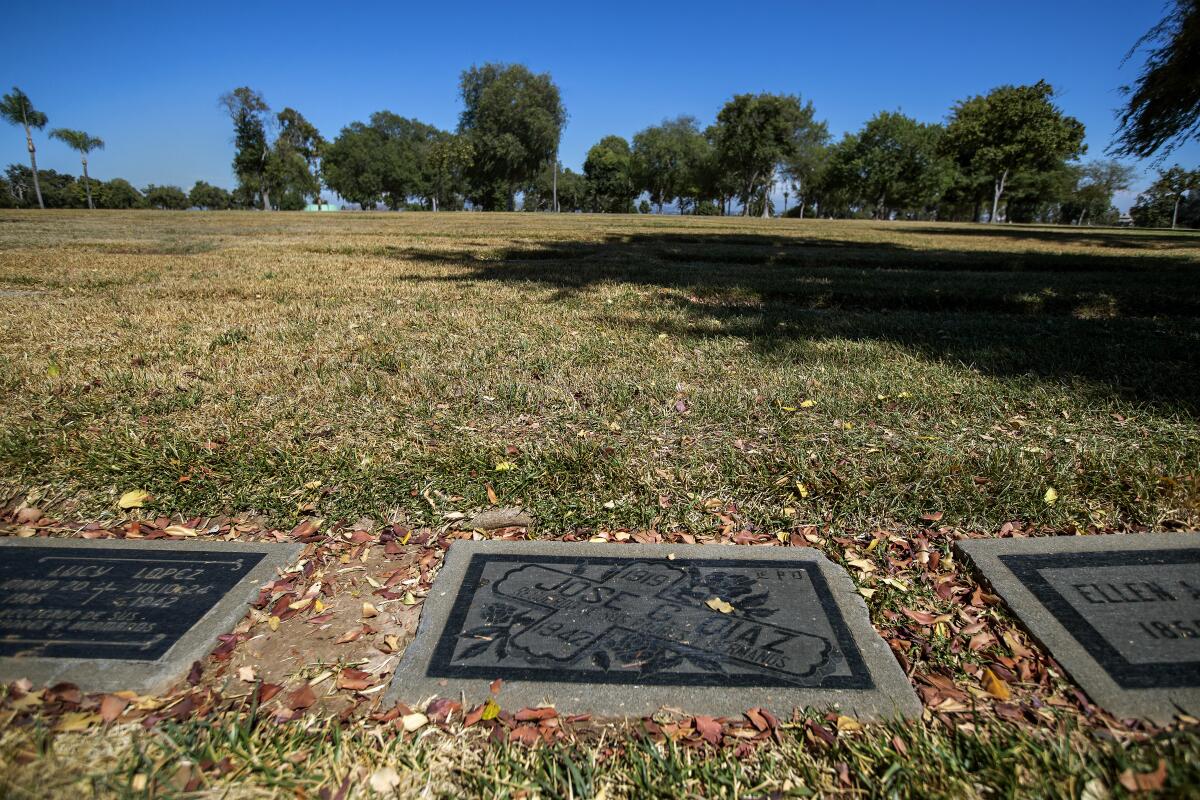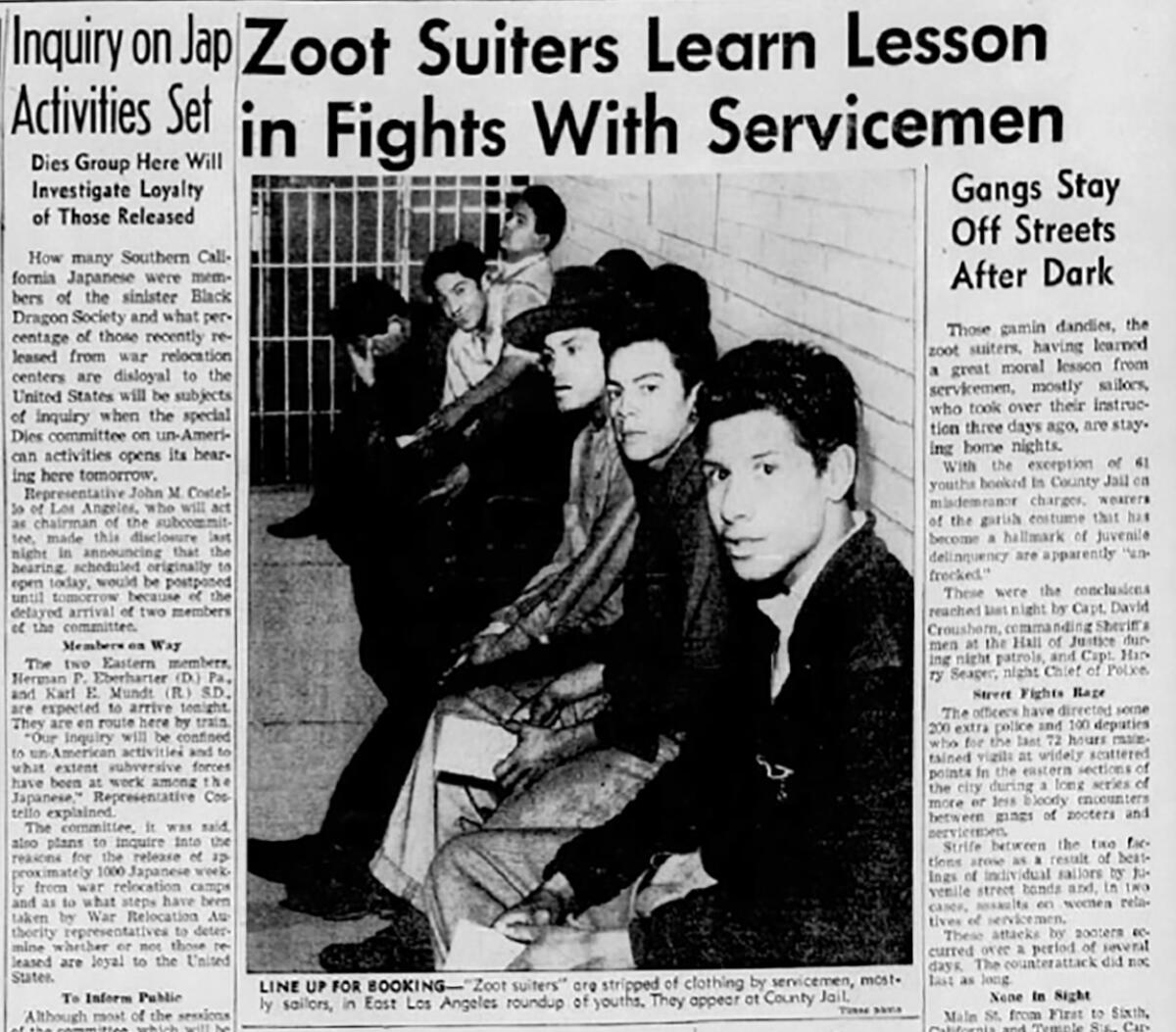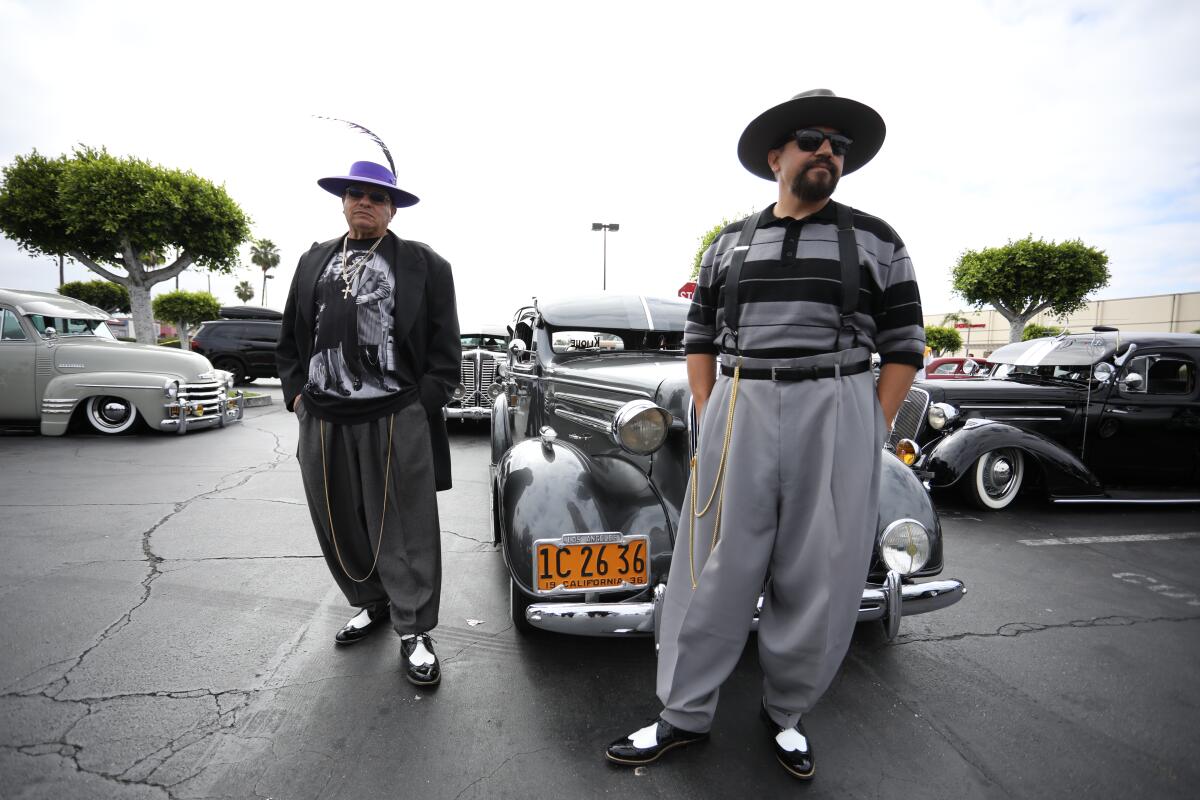Column: Sleepy Lagoon, the Zoot Suit riots and the lonely grave in East L.A. that history has forgotten

- Share via
Jose Diaz’s grave lies in an elevated section of Calvary Cemetery in East Los Angeles, with views of the 60 Freeway and the Metro Gold Line. From here, you can see a good section of the Eastside.
What you can’t sense from here is how Diaz’s death profoundly changed L.A. His final resting place is one of thousands of long-forgotten tombs in one of the city’s oldest cemeteries. He deserves so much more.
In the early hours of Aug. 2, 1942, the 22-year-old was found on the side of a road in what’s now Montebello with a fractured skull, a broken finger, pants pockets turned inside out and stab wounds to his abdomen. Diaz, who had just left a party where a fight broke out, died hours later at Los Angeles County General Hospital.
Within days, police officers rounded up hundreds of young Mexican American men in what became known as the Sleepy Lagoon case, after a reservoir used by Latinos as a swimming hole at a time when public pools were segregated.
The district attorney charged 22 of them with Diaz’s murder; a jury sent 12 of the accused to San Quentin; a judge sentenced a group of teenage girls to reform school for refusing to cooperate with authorities.
The local press — including this paper — demonized Mexican youths as inherently violent and un-American, especially because of the big coats, bigger pants and large hairstyles they wore in the face of wartime rationing. Less than a year later, this racist stew devolved into the so-called Zoot Suit riots, at which white servicemen assaulted Mexicans in and around downtown L.A. and Boyle Heights while law enforcement largely looked on and the media cheered.
After a three-month trial, an all-white jury convicted a dozen young Mexican American men of killing Jose Diaz, 22, at an Eastside swimming hole that became known as Sleepy Lagoon.
The double injustices of the trial and the riots galvanized the Mexican American community. The Sleepy Lagoon Defense Committee, supported by Hollywood stars like Orson Welles and Rita Hayworth and crusading journalists Carey McWilliams and Charlotta Bass, paid for the successful appeals of all of the defendants convicted of Diaz’s murder and publicized their cause. Subsequent generations of Chicanos healed the communal scar of the Zoot Suit riots by mythologizing pachucos y pachucas — a once-derogatory nickname for the Chicano guys and gals of the era who dressed the part — as rebels who stood up to a racist justice system.
This history remains oft-repeated across Southern California in movies, plays, television shows, songs and social media. There’s just one person almost always overlooked in this tale.
Diaz.
That’s why this month, on the 80th anniversary of his death, I went to his grave to pay my respects — and to see if anyone else might do the same.
At 8 in the morning, the only sounds were the far-off lawn mowers of groundskeepers and the crunch of dried grass underneath my feet.
Ants crawled across Diaz’s tombstone, a concrete slab overlaid by a metal stencil of a cross surrounded by roses. His full name and years of life were in the middle, along with the legend “Recuerdo de sus padres y hermanos” — “A memento of Jose’s parents and siblings.” On the top right corner was the abbreviation EPD for en paz descanse — rest in peace.
As I waited for other mourners to arrive, I brushed up on reading material I had brought for the day that revealed Diaz never found any peace in death.
Whenever I cover demonstrations against Police Chief Daryl F.
No one was ever convicted of Diaz’s murder, which remains an open case, and no one ever gave authorities any legitimate leads.
I thumbed through a fundraising pamphlet published by the Sleepy Lagoon Defense Committee that stated, with no evidence whatsoever, that Diaz died because he was drunk and fell into a ditch, then was run over by a car.
I skimmed over “Zoot Suit,” the iconic play by Chicano legend Luis Valdez that turned into an iconic film starring another Chicano legend, Edward James Olmos. On both stage and screen, Diaz’s murder merits just a couple of lines to not distract from the supposedly bigger tragedy of what happened to his accused killers and the victims of rioting sailors and soldiers.
I pulled up on my phone a 2020 story by my colleague Carolina A. Miranda about a proposed monument to the Sleepy Lagoon trial and Zoot Suit riots at Riverfront Park in Maywood, across the Los Angeles River from where Diaz’s body was found and just down the 710 Freeway from Calvary Cemetery. The monument’s creators described what happened to Diaz as an “incident” that shouldn’t overshadow everything else that followed.
I waited. No one stopped by. I went to lunch.

There was a new soundtrack at Cavalry when I returned — weeping. Funerals. The living remembering the recently departed. Wreaths and casket flowers prettied the scene. None bloomed yet for Diaz.
He was buried in an area where almost everyone around him had also passed away in 1942. Steps away from his grave was a section for infants and small children. Many had the same tombstone design as the one that Diaz’s family picked — but underneath “EPD,” they featured bubble-glass portraits of the deceased.
On my phone, I reviewed notes from an interview with Arizona State history professor Eduardo Obregón Pagán. His 2003 book “Murder at the Sleepy Lagoon: Zoot Suits, Race, & Riot in Wartime L.A.” remains the only major work that spent any time on who Diaz was.
“It’s a series of injustices that came out of his death,” Pagán told me. “After that, he was completely lost.”
Pagán’s book revealed that Diaz was a farmworker, the eldest son of a Mexican immigrant family who was supposed to report to Army boot camp the day after he died. The professor tracked down two of Diaz’s surviving siblings, who said their family was devastated by his death and were pained any time Chicanos lionized the Sleepy Lagoon defendants. Diaz, they felt, was little more than a sacrificial lamb at the altar of pachuquismo.
“Joe was emblematic of so much indifference that has gone on and goes on about Mexican workers,” Pagán said, referring to Diaz by the name his siblings called him and that he had signed on his draft card. “He meant nothing to the public other than what contributions he could make to them.”
Pagán didn’t discount the legal travesty that was the Sleepy Lagoon trial and the Zoot Suit riots. But he did peg the erasure of Diaz’s story partly on Valdez’s “Zoot Suit” play.
“Given its purpose was to tell the story of defiant Chicanismo in the face of oppression, Joe’s story doesn’t really fit with that,” he said. “As a piece of advocacy art, [the play] was very effective. But it’s not history.”

I left Calvary for a couple of hours to do some errands and returned around 4, now bearing flowers I bought from a street vendor and a prayer card of the Virgin of Guadalupe from a Catholic gift shop. The funerals were over, the groundskeepers were gone. Families visited other gravesites. Ice cream trucks chimed in nearby neighborhoods. The bells tolled at Our Lady of Guadalupe Sanctuary on the other side of 3rd Street, north of the cemetery.
Messages I sent to Diaz’s surviving family were never returned. But as I approached his grave, I saw the telltale plastic wrap of a bouquet. Had I missed a visitor? No, the flowers were on the grave of someone else who died in 1942.
I stayed until the cemetery closed at 6. No one passed by to leave a recuerdo.
A week later, Pagán sent me transcripts of interviews that two of Diaz’s late siblings, Lino Diaz and Soccoro Diaz Blanchard, had granted to “American Experience.” The PBS history series aired a one-hour episode on the Zoot Suit riots in 2002 but never used the interviews, reducing the life of Joe Diaz to the only known photo of him: a slight smile, sporting a sharp mustache and wearing a pachuco-style wide-collared shirt.
Lino told director Joseph Tovares that his family had suffered an injustice. The Sleepy Lagoon defendants, he felt, made a mockery of his brother’s death by giggling through their trial, while the local papers “never explained anything about our family, our background.” Worse, his father suffered a nervous breakdown after his brother’s death and shunned Lino’s son for the simple reason that the boy’s name was also Joe.
Blanchard felt the same grief. “We hadn’t even started to get over [Joe’s] death” when the Sleepy Lagoon defendants were released, she told “American Experience.” At one point, someone at work handed her a petition asking that her brother’s accused killers be released. She tore it up.
“All the publicity had been for them,” Blanchard said, “and nothing about what had happened to my [family], nothing. It was always about those young men.”
There will be much attention paid to those men next June, on the 80th anniversary of the Zoot Suit riots. There will be symposiums, car cruises, lectures and so much more. We should remember the injustices wrought against the Sleepy Lagoon defendants, against the pachucos beaten and humiliated in public for the simple act of being Mexican, and make sure racist hysteria never grips Los Angeles again.
But in the midst of all that, I hope someone leaves flowers on the grave of Jose Diaz.
More to Read
Sign up for Essential California
The most important California stories and recommendations in your inbox every morning.
You may occasionally receive promotional content from the Los Angeles Times.











